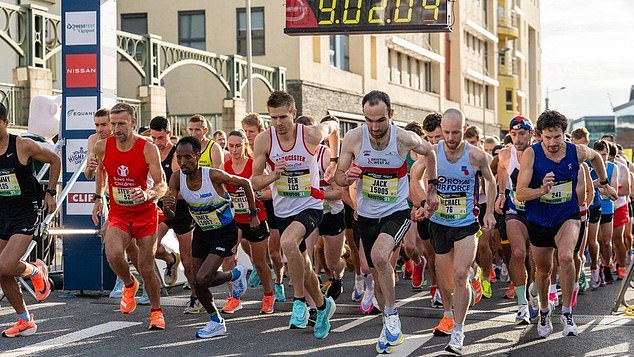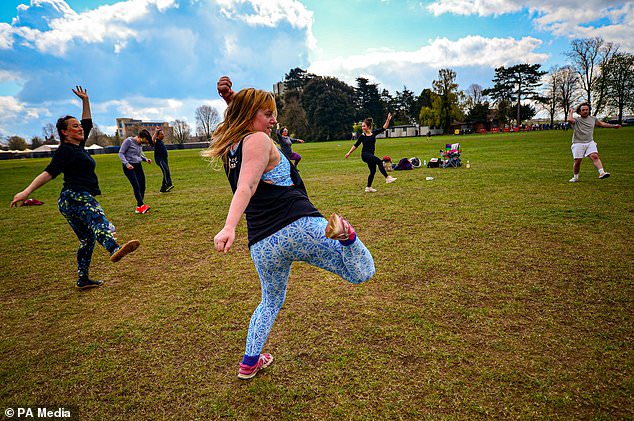Exercise ‘paradoxically’ increases levels of plaque in the arteries linked to heart disease, a study has found.
Research found that intense physical activity accelerates the build-up of calcium deposits — a type of hardened plaque — in the heart arteries.
High levels of calcium in blood vessels, measured through a CT scan, are seen as one of the strongest risk factors for heart attack and heart disease.
Patients who have a ‘calcium score’ of over 100 units are routinely offered preventative tablets such as statins to ward off a heart attack or stroke.
But new research, published today in the British journal Heart, found that people who exercise a lot accumulate significantly higher levels of calcified plaque.
The researchers said this does not mean that exercise is bad for the heart and that keeping fit remains ‘one of the best ways of trying to control cardiovascular risk’.
But they said this ‘calcium paradox’ could indicate that calcium levels are not as good a measure for heart health as previously thought.

Research by the University of Leicester has found that intense physical activity accelerates the build-up of calcium deposits — a type of hardened plaque — in the heart arteries. Pictured: The start of the Bristol Half Marathon on Sunday
These plaques cause the arteries to harden and narrow, restricting the blood flow and oxygen supply to vital organs.
Increased plaque in the arteries is usually linked to poor health and smoking, drinking and obesity.
Experts from the University of Leicester argued that ‘clinicians should be cautious regarding the overuse of this test in otherwise healthy individuals’.
They suggested that measures of non-calcified plaque, which is more likely to rupture, may be more important than calcified plaque in leading to heart attacks.
Currently CT scans which screen for heart disease do not distinguish between these two different types of plaque.
Scientists tracked 25,485 healthy adults in South Korea over an average of three years, comparing the amount of exercise they did with their calcium scores.
Overall, those who exercised the most tended to have the highest levels of calcium in their arteries.

Pictured: People take part in an outdoor AfroFusion dance exercise class on The Downs, Clifton, Bristol
Higher physical activity was linked to a more rapid progression of calcified plaque in the arteries over the study period.
The study said that exercise may lead to a narrowing of the arteries through mechanical stress on the vessels, alongside responses in the body such as increased blood pressure.
Author Professor Eliseo Guallar, of Johns Hopkins University in the United States, concluded: ‘Patients and physicians need to consider that engaging in physical activity may accelerate the progression of coronary calcium, possibly due to plaque healing, stabilisation and calcification.’
But he stressed that the cardiovascular benefits of physical activity ‘are unquestionable’, adding: ‘Physical activity may increase CAC scores without increasing cardiovascular disease risk.’
In a linked editorial Dr Alastair James Moss, a British Heart Foundation lecturer at the University of Leicester, said the study highlights the ‘complexity’ of interpreting calcium scores in patients who also do lots of exercise.
He added: ‘It may be the target we need to look for is non-calcified plaque rather than calcified plaque.
‘Increasing rates of coronary artery calcification is a phenomenon that is observed both in response to effective treatment like statin therapy and exercise. But it shouldn’t necessarily be regarded that serial imaging with calcium scans is the best way to accurately assess [cardiovascular disease] risk in these individuals.
Dr Moss added: ‘Clearly, exercise is one of the best ways of trying to control cardiovascular risk.’ He said more research was needed to get to the bottom of the ‘coronary artery calcium paradox’.
Dr Moss said: ‘The reason this is a paradox is calcified plaque is considered to be a barometer of heart disease risk.
‘You would expect that if you have a high burden of coronary artery calcification the intervention would potentially reduce or stop the progression of calcified plaque.
‘Yet with statins and also with exercise, it doesn’t appear to do that.’
Source link : https://www.dailymail.co.uk/health/article-10010943/Exercise-contribute-narrowing-arteries-research-suggests.html











